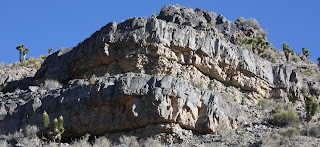Meiklejohn peak is an middle Ordovician (Whiterockian) lime mud-mound which grew on the edge of a large carbonate ramp that was itself fairly distal (~10-100’s of km) to the Ord. coastline. The picture below shows the mud-mound in outcrop; that’s all depositional topography, by the way. The mound has several jumbled up and cemented breccias and slump-block along its edge, and according to Krause (2001) may have had a depositional slope of up to 55°!

Underlying the mound is the Ord. (Ibexian) Nine Mile shale, which had some rare trilobite bits and some bioturbation. The mound is overlain by the Antelope Valley Limestone, which is supposed to be fairly fossiliferous. Interestingly, the mound itself looks fairly abiotic, with no clear evidence for reef-builders or bafflers. What is present, however, is considerable evidence for very early cementation, in the form of “zebra-rock”, shown below.

This stuff is pretty crazy stuff, and apparently is a fairly poorly-understood rock. The white-bands are early cements that apparently grew in situ within the carbonate mud; you can see how some of the bands merge and bifurcate, maybe suggesting that they have an anastomosing network geometry in three-dimensions. Apparently, some workers have used these to infer the presence of clathrates near the mound, which would provide a mechanism for early carbonate precipitation within the sediments.
A brief jaunt into the adjacent and overlying Antelope Valley Ls provided a respite for the more paleo-oriented in the group, in the form of some gastropods (pictured below, from another fellow field-tripper).

In the afternoon, we slipped into Death Valley via the road from Beatty, which cuts through some nicely exposed alluvial fan and reworked fan conglomerates, and stopped by what must be THE MOST PHOTOGRAPHED SAND DUNES IN THE WORLD. Seriously, tourists seems to really like the ol’ sand dunes.
The sand was actually really interesting, petrologically; in addition to rounded fine-grained quartz, there were also lots of sand-sized basalt grains and volcanic glass, which were getting concentrated on little deflation surfaces along ripple crests. Additionally, there were some pretty nice mud-cracked, fine-grained, interdune deposits. Even for someone notoriously inept at picture-takin' (like me), it was fairly photogenic:

There were some nice exposures of cross-stratification under some of these surfaces, as shown below:

Tomorrow, I’ll show you guys some absolutely awesome debris flow stuff, so stay tuned!












